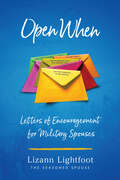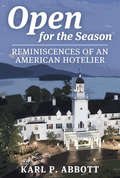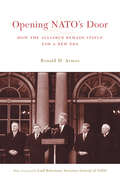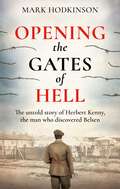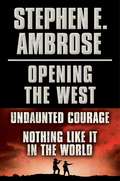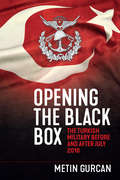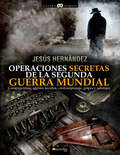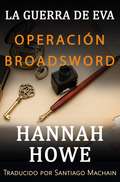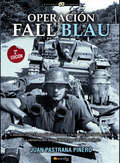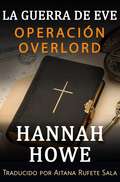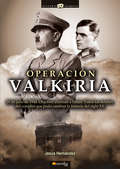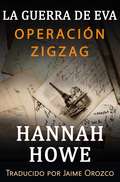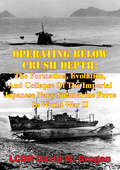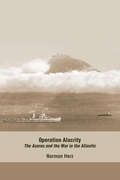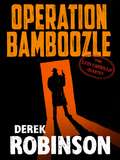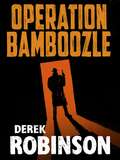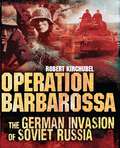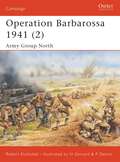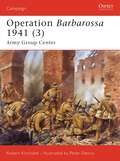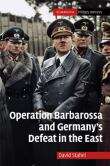- Table View
- List View
Open When: Letters of Encouragement for Military Spouses
by Lizann LightfootA collection of encouraging, informative letters to read when facing the challenges of military life."... feels like a tight hug from a friend who gets it ..."—Becky Hoy, founder of Brave Crate, cofounder of PILLAR"... if you are a brand new military spouse ... or a seasoned military spouse, there is a letter in this book for you ..."—Brittany Boccher, 2017 AFI Military Spouse of the Year and founder of Discover Your SparkDear Military Spouse,I wrote these letters to encourage you throughout your military life journey. Whether you are celebrating a milestone, surviving an unfamiliar challenge, or feeling unheard, you are not alone.I am here with you, from the first moments of falling in love with your service member, to attending your first military ball, giving birth while your spouse is deployed, and moving across country (or an ocean) on short notice. I know what it's like to be making new friends—again and again, finding strength to support other spouses in the community, preparing to leave active duty, and many other military life moments in between.This collection of Open When letters is meant to deliver that special message from a friend who understands, whenever you need reassurance, helpful ideas, or a simple reminder of your own strength. We've got this!With love from a fellow military spouse,Lizann LightfootThe Seasoned Spouse"... Every letter in this book is unbelievably relatable to every chapter in my life as a military spouse ..."—Jen Pilcher, Navy spouse and founder of MilSpousefest"... The perfect gift for every military spouse in every walk of life. Truly a MUST READ."—Noralee Jones, writer and creator at Mrs. Navy Mama
Open for the Season
by Karl P. AbbottOpen for the Season, first published in 1950, is the entertaining, informative memoir by Karl Abbott of his family's long-time ownership and operation of hotels, inns, and resorts, from New Hampshire, to Boston, South Carolina, and Florida. Beginning with his childhood in his family's New Hampshire resort, The Uplands, Abbott would go on to manage or own popular hotels, inns, and resorts such as the Gasparilla Inn in Boca Grande, Florida, the Sagamore Resort in Lake George, New York, and the Hotel Vendome in Boston. Abbott paints a vivid picture of life at his properties, as well as providing insights into daily management, stories of his guests and workers, and what it took to be successful in the hotel business.
Opening NATO's Door: How the Alliance Remade Itself for a New Era (A Council on Foreign Relations Book)
by Ronald AsmusHow and why did NATO, a Cold War military alliance created in 1949 to counter Stalin's USSR, become the cornerstone of new security order for post-Cold War Europe? Why, instead of retreating from Europe after communism's collapse, did the U.S. launch the greatest expansion of the American commitment to the old continent in decades? Written by a high-level insider, Opening NATO's Door provides a definitive account of the ideas, politics, and diplomacy that went into the historic decision to expand NATO to Central and Eastern Europe. Drawing on the still-classified archives of the U.S. Department of State, Ronald D. Asmus recounts how and why American policy makers, against formidable odds at home and abroad, expanded NATO as part of a broader strategy to overcome Europe's Cold War divide and to modernize the Alliance for a new era.Asmus was one of the earliest advocates and intellectual architects of NATO enlargement to Central and Eastern Europe after the collapse of communism in the early 1990s and subsequently served as a top aide to Secretary of State Madeleine Albright and Deputy Secretary Strobe Talbott, responsible for European security issues. He was involved in the key negotiations that led to NATO's decision to extend invitations to Poland, Hungary, and the Czech Republic, the signing of the NATO-Russia Founding Act, and finally, the U.S. Senate's ratification of enlargement.Asmus documents how the Clinton Administration sought to develop a rationale for a new NATO that would bind the U.S. and Europe together as closely in the post-Cold War era as they had been during the fight against communism. For the Clinton Administration, NATO enlargement became the centerpiece of a broader agenda to modernize the U.S.-European strategic partnership for the future. That strategy reflected an American commitment to the spread of democracy and Western values, the importance attached to modernizing Washington's key alliances for an increasingly globalized world, and the fact that the Clinton Administration looked to Europe as America's natural partner in addressing the challenges of the twenty-first century.As the Alliance weighs its the future following the September 11 terrorist attacks on the U.S. and prepares for a second round of enlargement, this book is required reading about the first post-Cold War effort to modernize NATO for a new era.
Opening The Gates of Hell: The untold story of Herbert Kenny, the man who discovered Belsen
by Mark HodkinsonHerbert Kenny, an army dispatch rider, was the first Allied soldier to push open the gates at Belsen Concentration Camp, in April 1945. He kept his story from the world until an encounter with a trainee journalist brought it to light. Now, forty years on, that reporter is ready to share Herbert's incredible tale with the world. With unprecedented access to Herbert's diaries, letters and interviews, Mark Hodkinson brings to life the harrowing conditions of Belsen and its eventual liberation. From the events leading up to its gruesome discovery, to the trauma Herbert faced and his abandonment in the aftermath, this is a testament to the power of one person in the face of unimaginable darkness.This is the tale of an ordinary man thrown into an extraordinary, life-changing situation. How can a person cope when they come face-to-face with history's darkest moment? Herbert Kenny was that man. This is his story.'I have carried this story for many years, as Herbert did. I have written it because I owe it to him and others, the unknown and unsung, who, across many areas of life, have been burdened indiscriminately by great adversity and grief. They do really walk among us. And their grace, humility and strength is inspirational. While this is a tale of systematic malevolence, it is also about the resilience of the human spirit and a celebration of hope: there is more good than bad in the world, however it may sometimes seem.'
Opening The Gates of Hell: The untold story of Herbert Kenny, the man who discovered Belsen
by Mark HodkinsonHerbert Kenny, an army dispatch rider, was the first Allied soldier to push open the gates at Belsen Concentration Camp, in April 1945. He kept his story from the world until an encounter with a trainee journalist brought it to light. Now, forty years on, that reporter is ready to share Herbert's incredible tale with the world. With unprecedented access to Herbert's diaries, letters and interviews, Mark Hodkinson brings to life the harrowing conditions of Belsen and its eventual liberation. From the events leading up to its gruesome discovery, to the trauma Herbert faced and his abandonment in the aftermath, this is a testament to the power of one person in the face of unimaginable darkness.This is the tale of an ordinary man thrown into an extraordinary, life-changing situation. How can a person cope when they come face-to-face with history's darkest moment? Herbert Kenny was that man. This is his story.'I have carried this story for many years, as Herbert did. I have written it because I owe it to him and others, the unknown and unsung, who, across many areas of life, have been burdened indiscriminately by great adversity and grief. They do really walk among us. And their grace, humility and strength is inspirational. While this is a tale of systematic malevolence, it is also about the resilience of the human spirit and a celebration of hope: there is more good than bad in the world, however it may sometimes seem.'
Opening of the West: E-Book Boxed Set
by Stephen E. AmbroseThis ebook box set includes the following books by Stephen E. Ambrose, focusing on the ingenuity and the hardships that shaped the American West: Undaunted Courage: This #1 New York Times bestseller gives a sweeping account of the most momentous expedition in American history. Ambrose follows the Lewis and Clark Expedition from Thomas Jefferson's hope of finding a waterway to the Pacific, through the heart-stopping moments of the actual trip, to Lewis's lonely demise on the Natchez Trace. Along the way, Ambrose shows us the American West as Lewis saw it—wild, awesome, and pristinely beautiful. Nothing Like It in the World: A riveting account of an unprecedented feat of engineering, vision, and courage—this is the story of the men who built the transcontinental railroad. The US government pitted two companies—the Union Pacific and the Central Pacific Railroads—against each other in a race for funding, encouraging speed over caution, and their race brilliantly comes to life in Ambrose’s telling of the investors who risked their businesses and money; the enlightened politicians who understood its importance; the engineers and surveyors who risked, and sometimes lost, their lives; and the Irish and Chinese immigrants, the defeated Confederate soldiers, and all the laborers who did the backbreaking and dangerous work on the tracks.
Opening the Black Box: The Turkish Military Before and After July 2016
by Metin GurcanAs any other modern militaries of the world, Turkish Armed Forces (TAF) is a complex organization relying on human force and other resources provided by society, being strictly founded on both an institutional setting and a framework of values, norms and rituals, and producing security with means and ways available to achieve the strategic objectives of Turkey. This inherent complexity reflecting the structure-culture-action nexus often means that scholars study modern militaries of the world with separated disciplines: Political Science, International Relations, Sociology, Anthropology, History, Administrative Sciences, Economics and Security Studies. With this book, the author’s hope is to make these connections explicit to better understand the military change both within the Turkish military and the Turkish Civil-Military Relations (CMR) before and after failed military uprising on July 15, 2016. To better understand TAF’s change before and after July 15, this book, which has benefited a lot from the author’s PhD research, seeks to follow a pragmatic multi-method approach at different levels of analysis (i.e. data and method triangulation) and eclectic theoretical design which borrows theoretical elements from both institutionalist literature and literature on military sociology. In the book, relying on both his 20 yearlong insider experience within the Turkish military (both on the field and at the strategic corridors of the Turkish General Staff) and academic career, the author provides two snapshots, one about the pre-July 15 TAF and the Turkish CMR and other post-July 15 TAF and the Turkish CMR. It is worth noting that these snapshots have been enriched by empirical and qualitative scholarly insights seeking to examine the TAF as a security organization, TAF as a social institution and officership as a profession. In these snapshots, one would also find scholarly insights about the evolution of Turkish CMR over the last decade with a specific focus on the impact of the July 15 Military Uprising on the institutional identity of the Turkish military and the nature of the Turkish CMR.
Operaciones secretas de la Segunda Guerra Mundial (Historia Incógnita)
by Jesús Hernández MartínezLa Segunda Guerra Mundial no sólo se libró en los campos de batalla. Los servicios de inteligencia organizaron operaciones secretas para golpear al enemigo en su flanco más débil. Para ello recurrieron a hombres valientes y audaces, dispuestos a arriesgar su vida por cumplir una misión que, en la mayoría de casos, era prácticamente suicida. En esta obra se recogen estas operaciones que se suelen pasar por alto en los libros de historia pero cuyas consecuencias en el devenir de la guerra fueron peores de lo que se cree. Un nuevo título de Jesús Hernández, el mayor especialista en castellano en Segunda Guerra Mundial
Operación Broadsword (La Guerra de Eva. Saga de Heroínas de la DOE. #3)
by Hannah HoweOperación Broadsword es el tercer libro de la saga Heroínas de la Guerra de Eva de la DOE. El libro puede leerse de forma independiente. Sin embargo, para disfrutar al máximo de la serie, se recomienda leer los libros en orden. La Guerra de Eva es una serie de doce novelas. Cada libro contiene aproximadamente 20.000 palabras y una historia completa. Tenga en cuenta que el precio a lo largo de la serie será el mínimo y que el arco argumental de Eve concluirá al final de la serie. Mientras Mimi examinaba su equipo inalámbrico, una figura emergió en la oscuridad. Tenía más de treinta años y poseía unos hombros anchos y una estructura musculosa, mientras que una nariz orgullosa y un bigote bien recortado dominaban sus apuestos rasgos. “Los búhos son ruidosos esta noche”, dijo el hombre revelando una voz dotada de un profundo barítono. –Se permite hacer ruido cuando se es el más sabio de los pájaros, –respondí. Una vez establecidas nuestras palabras clave, el hombre se adelantó y me estrechó la mano. Su apretón de manos fue firme mientras su acción de bombeo amenazaba con quitarme el brazo del hombro. –Soy Jean-Claude, sonrió. –Jean-Claude Quiniou. Le acompañaré al piso franco y le presentaré a la familia Le Roux". –Soy Genoveva, –contesté, –y ella es Lise. Por supuesto, utilicé nuestros alias, ya que Eve y Mimi pertenecían a otra vida.
Operación Cerrojo (La Guerra de Eva. Heroínas de la DOE. #2)
by Hannah HoweDescripción del libro: La Guerra de Eva es una serie de doce novelas. Cada libro contiene aproximadamente 20.000 palabras y una historia completa. Por favor, tenga en cuenta que el precio a lo largo de la serie se fijará en el nivel mínimo y que el arco de la historia de Eve se concluirá al final de la serie. —Entiendo que desea regresar a Francia, dijo el hombre detrás del escritorio de caoba. —Eso es correcto, —dije. —¿Su motivación? —preguntó, afinando las esquinas de su bigote. —Para poner mi granito de arena en el esfuerzo de la guerra, para derrotar a los nazis y descubrir lo que le ha sucedido a mi marido —afirmé. —Eso sería extremadamente arriesgado, incluso suicida para una mujer solitaria emprender tal aventura. Sin embargo, hay una alternativa, —dijo el hombre de aspecto de oficial. —¿Cuál alternativa? Fruncí el ceño. —Sí. Le lanzaremos en paracaídas, como uno de los nuestros. Por supuesto, usted tendría que realizar el entrenamiento primero. Un entrenamiento riguroso. Formación de alto secreto. Si fallas, me temo que significará un periodo en el letargo, posiblemente hasta que la guerra finalice. —¿El letargo? —Pero confío en que no llegará a eso, —aseveró, ignorando mi pregunta. —¿Cuándo puede comenzar? Comencé inmediatamente. Y durante mi entrenamiento conocí a dos personas que cambiarían radicalmente mi vida: Guy Samson y Mimi Duchamp. También descubrí secretos sobre mí misma y habilidades más allá de mi imaginación. Sin embargo, a medida que el entrenamiento se calentaba, las situaciones se volvían demasiado reales, hasta que llegaron a un punto en el que tuve que matar, o morir.
Operación Fall Blau (Historia Incógnita)
by Juan Pastrana PiñeroJunio de 1942. Alemania lanza la ofensiva definitiva contra la Unión Soviética. El destino de la II Guerra Mundial se concentra en el Cáucaso, en una batalla apocalíptica que finalmente conduce a la derrota del Tercer Reich. En el verano de 1942, la Segunda Guerra Mundial se encontraba en su apogeo. La entrada en la guerra de los Estados Unidos había dado a la contienda una dimensión auténticamente mundial, pero en ese momento, el destino de todo el conflicto se centraba en las infinitas estepas del sur de la Unión Soviética. Enfrentada a la pesadilla de una guerra en dos frentes, Alemania intentó acabar con dicha situación concentrando la mayor parte de sus recursos militares disponibles para dar un golpe definitivo. Con la esperanza de aniquilar económicamente a la Unión Soviética e inducirla a firmar la paz, las fuerzas del Tercer Reich, junto con grandes contingentes de sus aliados italianos, rumanos y húngaros, se lanzaron a la conquista de todo el sur de la Unión Soviética, en una de las mayores operaciones militares de la historia. En esta obra, el historiador Juan Pastrana analiza el punto de partida de la ofensiva alemana, sus esperanzas y los errores que se cometieron, así como las repercusiones sobre el Cáucaso tras la retirada de las tropas del Eje. Conozca una ofensiva que podía haber cambiado el curso de la Segunda Guerra Mundial, y en cuyo desenlace podemos encontrar el germen tanto del nacionalismo checheno como de los deseos de independencia de los actuales Estados que conforman el Cáucaso.
Operación Nimrod: el asedio a la embajada iraní
by Russell Phillips Catherine Vidal GonzálezAl efectuar una extensa investigación, la Operación Nimrod nos (alejará de los mitos y revelerá la verdad) sobre aquellos seis largos días, junto al dramático rescate que desplegó el SAS bajo la mirada pública. El 29 de abril de 1980, la policía británica le aseguró a Irán que su embajada era segura. Sin embargo, al día siguiente, los terroristas asediaron la embajada y tomaron veinte y seis rehenes. El gobierno iraní estaba dispuesto a que los rehenes se convirtieran en mártires, mientras que el gobierno británico solo estaba dispuesto a conversar si los terroristas se rendían. A toda esta tensión se añadían los veinte y seis rehenes que pendían de un hilo. A esto le siguieron seis días de terror y tensión. No obstante, todo finalizó cuando el SAS comenzó la operación de rescate televisada en vivo, mientras millones de personas contenían su respiración, a la espera de poder ver el resultado de la Operación Nimrod. Compra este libro para saber la verdad acerca de la misión de rescate más dramática que asumió el SAS.
Operación Overlord
by Hannah HoweFuera había oscuridad total. Dentro, Guy parecía calmado, sus rasgos no dejaban ver emoción alguna. Mimi estaba inquieta, sus pequeños píes entraban en constante contacto con la tarima. Henri y Paul bromeaban por medio de lenguaje de signos. Hélène y Kadia se miraban nerviosas. Aymer masticaba una caña de maíz mientras se apoyaba contra la pared. Jean-Claude afilaba su cuchillo con una piedra de afilar. Bernard intentaba sintonizar la radio, para encontrar señal. Yo acariciaba mi vientre, intentando distinguir mis nervios de las patadas del bebé. Se escuchó el fuerte sonido de un reloj de pie en el pasillo. Les sanglots longs des violons de l’automne. Todas nuestras miradas se dirigieron a la radio. Nos quedamos en silencio cuando escuchamos las palabras del locutor. Era la primera estrofa del poema de Paul Verlaine; «Chanson d’automne», los largos sollozos de los violines de otoño. El locutor acababa de dar la señal que anunciaba el comienzo de la invasión.
Operación Rose: La guerra de Eve: Heroínas de la DOE (Serie Heroínas de la DOE #7)
by Hannah HoweOperación Rose es el séptimo libro de la serie La Guerra de Eve: Heroínas de la DOE
Operación Valkiria (Historia Incógnita)
by Jesús Hernández Martínez20 de julio de 1944. Von Stauffenberg se reúne en el cuartel general de Hitler. Porta un maletín con un explosivo inglés de 1 kg que se activa mediante un detonador químico absolutamente silencioso. Todo es perfecto, cree, y se sienta junto al líder nazi, Sólo queda esperar el momento...
Operación Zigzag: La Guerra de Eva; Las heroínas de la SOE
by Hannah HoweLa Guerra de Eva es una serie de doce novelas. Cada libro contiene alrededor de 20,000 palabras y una historia completa. Por favor, note que el precio de toda la serie se establece al nivel mínimo y que el arco histórico de la serie concluye hasta el último libro. Marsella, Diciembre de 1942 “Estamos en un aprieto” Dijo Vincent. “La Gestapo acaba de capturar a un agente británico con el nombre clave de Zigzag. Lo capturaron al descubrir que sus documentos de identidad eran falsos, y aunque aún no han descubierto quién es él realmente, estoy seguro que lo descubrirán y lo harán hablar. Al final de cuentas, todos lo terminan haciendo, y cuando lo haga, terminará revelando secretos que destruirán la red de resistencia local, incluyendo la nuestra. Pero hay una forma de salir de esto; a través de un guardia que esté dispuesto a sobornos. Queremos que lo encuentres y lo sobornes para que libere a Zigzag de la prisión de la Gestapo y después lo escoltes a través de las montañas, hasta llegar a España”. “¿Por qué yo?” Pregunté. “Porque tu ayudaste a establecer la red de escape y porque conoces los senderos de las montañas como si fueran la palma de tu mano. Además, al ser la esposa del respetado industrialista Michel Beringar no levantaras ninguna sospecha”. Miré a Michel. La mirada seria en su rostro me decía que no estaba contento. ¿Estaba arriesgando demasiado? ¿Y si levantaba sospechas y la Gestapo me seguía al espiar mi teléfono? Desde chica me escapé de casa. Cuando fui una adolescente viajé por el mundo viviendo de mi ingenio. Al ser periodista, presencié atrocidades hechas en nombre del fascismo. Siendo un miembro de la resistencia supe lo que era afrontar el miedo y vencerlo. He vivido lo suficiente estos últimos treinta años. Sé que puedo lograrlo. Sin embargo, incluso cuando expresé mi acuerdo, sabía que mi vida en Marsella y mi vida con Michel nunca vo
Operating Below Crush Depth: The Formation, Evolution, And Collapse Of The Imperial Japanese Navy Submarine Force In World War II
by LCDR David W. Grogan USNPrior to entering World War II, the Japanese Navy did a considerable planning and force development in preparation for a single "decisive battle" with the American fleet. The Japanese submarine force entered the war with highly trained crews operating some of the most capable submarines in the world. Even so, they accomplished little. This study will analyze the genesis and evolution of the technological basis of the Japanese submarine fleet before and during the war. Along with the technological evolution, it will also review the strategic and tactical evolution of the force. It will further analyze the employment of submarines as they apply to two major forms of naval warfare: guerre de course and guerre de main. While the entire study will use comparison with the American and German, the majority of the focus will be on the unique aspects of the Japanese employment of their submarines. These analyses will answer whether the Japanese submarine force would have been capable of influencing the results of major battles and the overall campaign in the Pacific Ocean. Could the Japanese submarine force have influenced the result of the war allowing it to end with a more favorable outcome for the Japanese?
Operation Alacrity
by Norman HerzTo win the war against German U-boats, the Allies had to protect their convoys in the vast black hole of the mid-Atlantic known as the Azores Gap. In 1943 they devised a plan to set up air bases on the Azores Islands, owned by neutral Portugal. It was essential for the operation to remain secret because the Allies had to get there before the Germans, who had their own plan to build bases. Author Norman Herz took part in the Allied operation as a corporal with the U.S. Army Corps of Engineers' 928th Engineer Aviation Regiment. At the time he was given little information about the operation and told never to talk about what he did. After the war, Operation Alacrity remained mostly unknown, kept secret, Herz suggests, so the U.S. government would not be embarrassed--they had claimed they would not invade the Portuguese territory. In researching the book, Herz found not a word of the operation mentioned in any official U.S. history of World War II but a treasure trove of declassified memos and others documents from the files of the U.S. Joint Chiefs of Staff and the Combined U.S. U.K. Chiefs of Staff and in state department files. The story is filled with diplomatic intrigue and double-dealing, including secret meetings between Franklin Roosevelt and Winston Churchill and Churchill's use of a 1373 treaty with Portugal to justly landing in the Azores. The story also involves all of the Allied engineering branches, from U.S. Navy Seabees to RAF Sappers. The success of their operation is undeniable. U-boats stopped patrolling the Azores Gap and not a single Allied troopship was lost again in the area. Today the base is an important link to American and NATO defense worldwide.
Operation Bamboozle
by Derek RobinsonFrom 1941 to 1943 it was the Germans. Then it was the turn of the British. Come the Cold War, he's conning McCarthy. Now he's going head to head with the L.A. mob.For high stakes con artist Luis Cabrillo, once known as Eldorado, the million-dollar spy, trouble is never far away. And when he and his corker-of-a-New-Yorker squeeze, Julie Conroy, run into the cream of Los Angele's shady side, the result is a heady brew of disorganized crime, hot dollars, triple virgins and dead bodies in the begonias. The fourth and final Luis Cabrillo novel is yet another fiendishly plotted rollercoaster ride of wit and wisecracking, as the Second World War's most daring and audacious spy finds that old habits die hard, even in peacetime.
Operation Bamboozle
by Derek RobinsonFrom 1941 to 1943 it was the Germans. Then it was the turn of the British. Come the Cold War, he's conning McCarthy. Now he's going head to head with the L.A. mob. For high-stakes con artist Luis Cabrillo, once known as Eldorado, the million-dollar spy, trouble is never far away. And when he and his corker-of-a-New-Yorker squeeze, Julie Conroy, run into the cream of Los Angeles' shady side, the result is a heady brew of disorganised crime, hot dollars, triple virgins and dead bodies in the begonias. The fourth and final Luis Cabrillo novel is yet another fiendishly plotted rollercoaster ride of wit and wisecracking, as the Second World War's most daring and audacious spy finds that old habits die hard, even in peacetime.
Operation Bamboozle
by Derek RobinsonFrom 1941 to 1943 it was the Germans. Then it was the turn of the British. Come the Cold War, he's conning McCarthy. Now he's going head to head with the L.A. mob. For high-stakes con artist Luis Cabrillo, once known as Eldorado, the million-dollar spy, trouble is never far away. And when he and his corker-of-a-New-Yorker squeeze, Julie Conroy, run into the cream of Los Angeles' shady side, the result is a heady brew of disorganised crime, hot dollars, triple virgins and dead bodies in the begonias. The fourth and final Luis Cabrillo novel is yet another fiendishly plotted rollercoaster ride of wit and wisecracking, as the Second World War's most daring and audacious spy finds that old habits die hard, even in peacetime.
Operation Barbarossa
by Robert KirchubelIn the first 6 months of Hitler's World War II Nazi invasion, over 5 million of Stalin's Russian troops were killed, wounded, or captured defending their Motherland. Germany's surprise assault on the Soviet Union in June 1941, Operation Barbarossa, aimed at nothing less than the destruction of the Soviet Union. Adolf Hitler saw this as the last vital step in the establishing of 'Lebensraum' for the German people in the East.Three German Army Groups, supported by numerous European allies, poured across the Soviet border crushing all before them in a lightning campaign that threatened to eliminate all Soviet resistance and secure an easy victory. However, the vast resources and size of Soviet Russia caused the German armoured spearheads to slow and the advance finally ground to a halt within sight of Moscow itself, and with it Hitler's dreams of a quick victory.This book combines Osprey's three Campaign titles on the Barbarossa campaign, along with new material specifically created, in order to tell the story of one of definitive campaigns of World War II.
Operation Barbarossa 1941
by Howard Gerrard Robert KirchubelOsprey's second title examining the events of Operation Barbarossa. Of the German Army Groups that attacked Soviet Russia, Von Leeb's Army Group North, tasked with seizing the Baltic States and Leningrad, was the smallest and weakest. General Kuznetzov's Northwestern Front, however, was in an even weaker state. Despite brave counterattacks and defense by the Soviet forces, the Germans smashed through the Dvina Line, then the Stalin Line, flooded into Latvia and pressed on to encircle Leningrad. This book examines the German offensive and also the courageous Soviet attempts to halt the German spearhead, defending every possible line against overwhelming odds.
Operation Barbarossa 1941
by Peter Dennis Robert KirchubelOsprey's third and final volume in the Barbarossa trilogy, this title completes the account of the strategic intricacies of the German campaign against Russia. Detailing the final Nazi push for Moscow, Robert Kirchubel examines the causes behind the German failure, including the inability to re-supply troops or provide reserves, and the lack of decent German winter uniforms and transport.Full-color artwork, maps and bird's-eye views illustrate the campaign in detail, revealing how the Red Army capitalized on every German weakness in spite of its own flaws.
Operation Barbarossa and Germany's Defeat in the East
by David StahelOperation Barbarossa, the German invasion of the Soviet Union, began the largest and most costly campaign in military history. Its failure was a key turning point of the Second World War. The operation was planned as a Blitzkrieg to win Germany its Lebensraum in the east, and the summer of 1941 is well-known for the German army's unprecedented victories and advances. Yet the German Blitzkrieg depended almost entirely upon the motorised Panzer groups, particularly those of Army Group Centre. Using archival records, in this 2009 book David Stahel presents a history of Germany's summer campaign from the perspective of the two largest and most powerful Panzer groups on the Eastern front. Stahel's research provides a fundamental reassessment of Germany's war against the Soviet Union, highlighting the prodigious internal problems of the vital Panzer forces and revealing that their demise in the earliest phase of the war undermined the whole German invasion.
